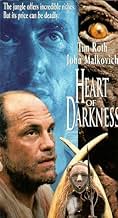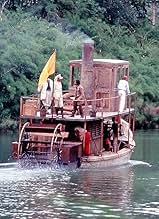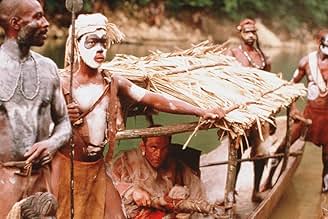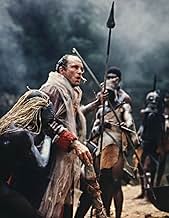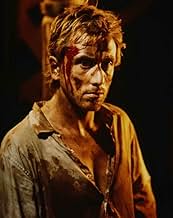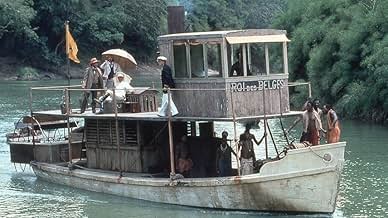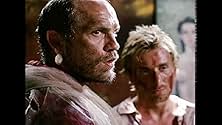CALIFICACIÓN DE IMDb
5.7/10
2.1 k
TU CALIFICACIÓN
Agrega una trama en tu idiomaA trading company manager travels up an African river to find a missing outpost head and discovers the depth of evil in humanity's soul.A trading company manager travels up an African river to find a missing outpost head and discovers the depth of evil in humanity's soul.A trading company manager travels up an African river to find a missing outpost head and discovers the depth of evil in humanity's soul.
- Ganó 1 premio Primetime Emmy
- 3 premios ganados y 3 nominaciones en total
- Dirección
- Guionistas
- Todo el elenco y el equipo
- Producción, taquilla y más en IMDbPro
Argumento
¿Sabías que…?
- TriviaWhen Orson Welles first set up his production deal with RKO in 1940, this was to be their first movie. Excessive costs made it too prohibitive and so they proceeded with El Ciudadano Kane (1941) instead.
- ErroresThe monkey in Kurtz' bungalow has a prehensile tail and is therefore not an African monkey, but a New World monkey.
- ConexionesFeatured in The 52nd Annual Golden Globe Awards (1995)
Opinión destacada
Heart of Darkness, directed by Nicolas Roeg, is an adaptation of Joseph Conrad's tale of ivory hunting in the African jungle. Heart of Darkness was a made for T.V. film, airing on March 13, 1994 on TNT (Turner Network Television). Auteur theorists analyzing previous Roeg films may agree that this T.V. adaptation does not hold the same attributes. One may argue that it was made for television, which would place guidelines on how much Roeg could express his autuerist style. Others may believe that Roeg' style is still at work within Heart of Darkness, even though it follows the Hollywood narrative. This film analysis will argue the Roeg elements are still at work. The film begins with extreme close ups of an elephants body. Next we see Marlow (Tim Roth) explaining his expedition of the African Jungle to a group of rich British men. From there, the film cuts to a large library or museum where we see two women in black, almost identical, sitting in the front entrance of an office. Marlow, in a voice over, begins to become uneasy with the women's presence. He makes comments to himself regarding a conspiracy and the women were warning him of something. If one has seen Don't Look Now (1973) they can make a predisposition toward the two women in black and the psychic sisters. Marlow had ambiguities toward the two women, just as John (Donald Sutherland) had toward the sisters, which predicted his outcome (death). Marlow on the other hand assumed danger from the two women and danger is exactly what he found in the Congo. As the film continues we see an aborigine standing outside of a window looking in at Marlow. We later find out that he committed suicide or was speared in the chest by an unruly army headed by Kurtz (John Malkovich). In Walkabout (1971) we see the young aborigine looking into the house at the white girl. In both films the aborigine's are looking into the white man's world. Unfortunately they find the white man's world can be destructive and greedy, as seen in the Kurtz controlled outlandish army. They steal young boys and barter them for supplies. Three young boys are abducted from the camp site, one boy is killed and the others are returned for supplies.
Previous to the abduction, we see random shots of a boy with an ivory necklace. We later see the necklace lying near where the boy had been sleeping. Immediately following the abduction is a dream sequence which Marlow sees a dead elephant, stripped of its' tusks, lying alongside a trail. Maggots are seen as the camera moves in for a close up. Juxtaposed with the elephant are the identical women and finally a claw tool. This sequence expresses the dangers associated with the Congo, not only on the explorers but aborigines and animals. These sequences are Roegian for its' underlying themes. What do two women, an elephant and a claw have to do with a journey in the Congo? The elephant is clearly associated with ivory and greed. The women mean a clear and present danger in the Congo. The claw depicts violence and is later seen sitting in Kurtz's hut. In one shot we see Mfumu looking into the water where it appears blood is floating on the surface, foreshadowing his own death. After he is speared Marlow throws his body overboard and blood floats atop the surface again. Roeg does not hold back on the grotesqueness within Heart of Darkness. In one scene we see another explorer repeatedly kicking and striking a black man. After Mfumu is speared, Marlow pulls on the spear and blood explodes from the chest. Surprisingly T.V. allowed this scene as well as a few others. Moments later Marlow and his guides enter Kurtz's village where there is a young boy covered in blood and tied to a tree. There are also boys' heads on stakes and on branches in trees. More boys are taken from the crew and traded, and one is killed. Kurtz's makes his appearance in the final 20 minutes of the film. He appears to be a god to the aborigine army. He is quite crazy and slowly dies away in a most unusual and unauthentic way. He is buried in an upright position and is draped in white cloth. There appears to be some sort of metal attachments from his upper body to his arms to keep them out in front of him. I am not sure what Roeg was getting at with this, but it may have to do with Kurtz being crazy and having instilled his own ideologies to the army. There is one theme in which is unusual. There is an aborigine woman that closely resembles Kurtz's white wife. The black beauty is framed with Kurtz's wife's painting. The black beauty appears to have some sort of skin ailment or body paint. Maybe Kurtz has put her up to painting or brandishing herself to slightly resemble his wife back in Britain. At the end of the film Marlow approaches the widow and tells her of Kurtz's last moments. This scene seems so out of place. The black and white woman reflecting each other in some sort of weird African fantasy makes sense, but Marlow actually going to see the widow has no real premise. It does appear Roeg intentionally mirrored Kurtz's loves, but the widow scene seemed so hurried. That did not at all seem Roegish. Finally the end montage near Kurtz's death is the most Roegistic style in the whole film. Roeg compiles every theme into about one minute of juxtaposed images containing Mfumu's death and the spear exiting his chest in slow motion. The elephant's rotting carcass, the two women being seen again, the ivory necklace and young boys are also shown again. Random shots of Kurtz's masked army are installed. The black and white women are repeated. Heart of Darkness is much so a Roeg film only with a T.V. limit.
Previous to the abduction, we see random shots of a boy with an ivory necklace. We later see the necklace lying near where the boy had been sleeping. Immediately following the abduction is a dream sequence which Marlow sees a dead elephant, stripped of its' tusks, lying alongside a trail. Maggots are seen as the camera moves in for a close up. Juxtaposed with the elephant are the identical women and finally a claw tool. This sequence expresses the dangers associated with the Congo, not only on the explorers but aborigines and animals. These sequences are Roegian for its' underlying themes. What do two women, an elephant and a claw have to do with a journey in the Congo? The elephant is clearly associated with ivory and greed. The women mean a clear and present danger in the Congo. The claw depicts violence and is later seen sitting in Kurtz's hut. In one shot we see Mfumu looking into the water where it appears blood is floating on the surface, foreshadowing his own death. After he is speared Marlow throws his body overboard and blood floats atop the surface again. Roeg does not hold back on the grotesqueness within Heart of Darkness. In one scene we see another explorer repeatedly kicking and striking a black man. After Mfumu is speared, Marlow pulls on the spear and blood explodes from the chest. Surprisingly T.V. allowed this scene as well as a few others. Moments later Marlow and his guides enter Kurtz's village where there is a young boy covered in blood and tied to a tree. There are also boys' heads on stakes and on branches in trees. More boys are taken from the crew and traded, and one is killed. Kurtz's makes his appearance in the final 20 minutes of the film. He appears to be a god to the aborigine army. He is quite crazy and slowly dies away in a most unusual and unauthentic way. He is buried in an upright position and is draped in white cloth. There appears to be some sort of metal attachments from his upper body to his arms to keep them out in front of him. I am not sure what Roeg was getting at with this, but it may have to do with Kurtz being crazy and having instilled his own ideologies to the army. There is one theme in which is unusual. There is an aborigine woman that closely resembles Kurtz's white wife. The black beauty is framed with Kurtz's wife's painting. The black beauty appears to have some sort of skin ailment or body paint. Maybe Kurtz has put her up to painting or brandishing herself to slightly resemble his wife back in Britain. At the end of the film Marlow approaches the widow and tells her of Kurtz's last moments. This scene seems so out of place. The black and white woman reflecting each other in some sort of weird African fantasy makes sense, but Marlow actually going to see the widow has no real premise. It does appear Roeg intentionally mirrored Kurtz's loves, but the widow scene seemed so hurried. That did not at all seem Roegish. Finally the end montage near Kurtz's death is the most Roegistic style in the whole film. Roeg compiles every theme into about one minute of juxtaposed images containing Mfumu's death and the spear exiting his chest in slow motion. The elephant's rotting carcass, the two women being seen again, the ivory necklace and young boys are also shown again. Random shots of Kurtz's masked army are installed. The black and white women are repeated. Heart of Darkness is much so a Roeg film only with a T.V. limit.
- revco1980
- 15 mar 2004
- Enlace permanente
Selecciones populares
Inicia sesión para calificar y agrega a la lista de videos para obtener recomendaciones personalizadas
Detalles
- Tiempo de ejecución1 hora 40 minutos
- Color
- Mezcla de sonido
- Relación de aspecto
- 1.33 : 1
Contribuir a esta página
Sugiere una edición o agrega el contenido que falta

Principales brechas de datos
By what name was Heart of Darkness (1993) officially released in Canada in English?
Responda

